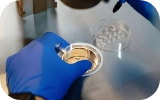IVF was originally developed for women with blocked tubes or missing fallopian tubes and it is still the procedure of choice for these situations. It is also used when other conditions are present, including endometriosis, male factor infertility and unexplained infertility in which no medical cause for infertility can be found. Our experts will review your history and help to guide you to the treatment and diagnostic procedures that are most appropriate for you.
1/3rd of the infertility issues are contributed by the male partner. Male factors also influence increased rate of miscarriages. Most common causes of male infertility are as follows.
- Abnormal sperm count or low sperm motility
- Chronic ailments such as cancer
- Environmental factors: Exposure to radioactive chemicals
- Lifestyle factors: Being overweight, smoking, drinking alcohol
- Age
Infertility is gender neutral. It affects the male and the female population. 1/3rd of the infertility issues are contributed by the female partner. In the world 50-80 million suffer from infertility. Most common causes of female infertility are as follows.
- Age
- Endometriosis
- Hormonal issues leading to ovulation problems
- Tubal blockage
- Fibroids
- Lifestyle factors: Being overweight, smoking, drinking alcohol, unhealthy diet
- Unexplained infertility
Women are born with approximately 2 million eggs in their ovaries. Before a girl reaches puberty, about 11,000 eggs die every month. Thus, in her teenage years, a woman has only about 300,000 to 400,000 eggs available. From this point onwards, about 1000 eggs are utilised every month. This has nothing to do with any form of birth control, pregnancy, hormone production, health, lifestyle or nutritional supplements. Eventually, a woman reaches menopause when she has no viable eggs left.
PCOS (Polycystic Ovarian Syndrome) refers to a condition caused by hormonal imbalances. Women suffering from PCOS produce higher than normal amounts of male hormones. This affects ovulation and can result in irregular periods. In some cases, women suffering from PCOS may have irregular periods. This, in turn, can make it harder for these women to conceive. In fact, PCOS is one of the most common causes of female infertility.
Endometriosis is a common disorder found in women, where the endometrial tissues grow outside the uterus. This gynaecological condition can occur in the ovaries, fallopian tubes, the tissues lining the pelvis, and in rare cases, abdominal cavity, too.
- Pelvic pain
- Abnormal bleeding
- Painful urination
- Painful sex
- Nausea or Vomiting
- Difficulty in getting pregnant
- Low immunity
Intrauterine insemination also known as artificial insemination is a non-invasive ART procedure. The procedure is simple, easy to perform, does not include extreme effort from the couple and costs less than advanced procedures such as IVF and ICSI. Generally, IUI is recommended for couples with good ovarian reserve and semen parameters, but with associated problems such as PCOS, minimal endometriosis, borderline sperm counts and motility, and also for unexplained infertility.
- Stimulation: Fertility medications to stimulate the ovaries to produce eggs.
- Egg Retrieval: An ultrasound aided retrieval of follicles will happen followed by embryologist assessing the egg quality and quantity
- Fertilisation and Embryo Culture: Either a standard IVF or ICSI is performed to fertilize the best quality eggs followed by assessment of the embryos for development.
- Embryo Transfer: The embryologist after sharing the assessment details with the fertility specialist schedules date for transfer. The fertility specialist performs the transfer in the uterine cavity
- Embryo Freezing & Storage: All unused embryos are frozen for future use incase of a failed pregnancy.
Oocyte cryopreservation, also known as egg freezing, is a process wherein a woman's eggs are extracted, frozen and stored for later use. Cryopreservation can prove to be extremely beneficial for women who have been diagnosed with cancer and are scheduled for some kind of oncological treatment like radiotherapy or chemotherapy. Women who are unmarried or are in a situation that is not conducive to childbearing, can also opt for oocyte cryopreservation.
It is important to recognize that the rate of birth defects in humans in the general population is about 3% of all births for major malformations and 6% if minor defects are included. Fortunately, 20-plus years following Louise Brown's birth (the first IVF baby), we now have ample data that children conceived through IVF have no increase in these rates of birth defects due to the technique itself. Minor rise in abnormalities is ascribed to the infertility and age factor of the intending parents. Further follow-up on older children indicates that IVF children have done as well or better than their peers in academic achievement (probably a social bias) and have no higher rates of behavioural or psychological difficulties.
- Avoid fast foods. Eat more home cooked meals instead
- Use more of vegetable oil for cooking
- Include more vegetable proteins such as fresh beans and nuts
- Avoid pasta, rice and sweets
- Choose full-fat milk, yogurt over skimmed ones
- A multivitamin with folic acid and vitamin B helps
- Avoid red meat. Increase intake of fruits and bean for iron
- Avoid beverages and drink more water
- Aim for an ideal body weight
- Some form of exercise is always good
PGT-A is genetic testing performed on embryos to identify numerical chromosomal abnormalities or aneuploidy. This test is performed on embryos prior to transfer into the uterus. By analysing all embryos generated in an IVF treatment cycle, those free of chromosomal aneuploidy can be identified for selective transfer. As a result, the pregnancy rates per transfer are increased and the miscarriage rates decreased.
PGT-M involves testing of embryos for specific monogenic disorders like thalassemia, haemophilia and certain types of muscular dystrophy. It helps couples who have a family history or those who have had a child affected with these disorders to have an unaffected child. All embryos formed as a part of an Assisted Reproductive Technology (ART) are tested for this specific monogenic disorder. Only unaffected or career embryos are transferred to have a disease free child. This can also be combined with PGT-A to further improve success rates.
PGT-SR tests people with chromosome rearrangements (structures that hold our genetic material is not of normal size or arrangement). These people are at risk of producing embryos with unbalanced chromosomal structure. Such embryos are not viable and can result in multiple miscarriages. PGT-SR tests embryos for such specific rearrangements and can help in selection of normal embryos for transfer.
For the first visit, you are asked to carry yours and your spouse's ID proofs. You will also be asked to carry any relevant medical reports and records if any.
Book your Appointment
Take your first step towards
happiness with India’s
Trusted Fertility Chain
Need help? Talk to our fertility experts.
Had an IVF Failure? Take a Second Opinion.
 Infertility Counselling
Infertility Counselling Female Infertility Treatment
Female Infertility Treatment Andrology Treatment
Andrology Treatment Fertility Enhancing Surgeries - Female
Fertility Enhancing Surgeries - Female Fertility Enhancing Surgeries - Male
Fertility Enhancing Surgeries - Male Endoscopy Treatment
Endoscopy Treatment IUI Treatment
IUI Treatment IVF Treatment
IVF Treatment ICSI Treatment
ICSI Treatment Advanced IVF Solutions
Advanced IVF Solutions Embryology
Embryology Vitrification Egg, Embryo, Sperm Freezing
Vitrification Egg, Embryo, Sperm Freezing Preimplantation Genetic Testing (PGT)
Preimplantation Genetic Testing (PGT) Donation Program Embryo / Egg / Sperm
Donation Program Embryo / Egg / Sperm Self-cycleTM IVF
Self-cycleTM IVF

 Self-cycleTM IVF
Self-cycleTM IVF





